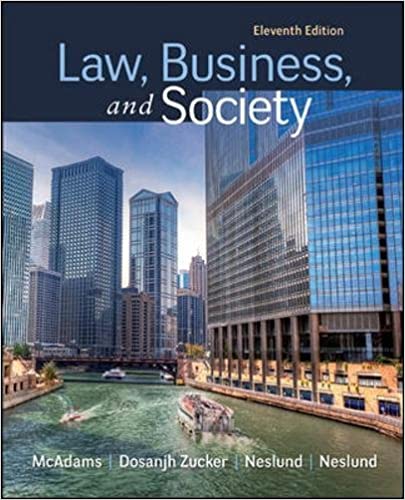
Law, Business and Society 11th Edition by Tony McAdams
Edition 11ISBN: 978-0078023866
Law, Business and Society 11th Edition by Tony McAdams
Edition 11ISBN: 978-0078023866 Exercise 1
Internet Access
As we have seen in other areas, market forces and legal regulation will blend in some uncertain, emerging formula to provide the security and confidence necessary for effective e-commerce. But ethics, too, will play a part. The speed, the traffic volume, the surface anonymity, and the global reach of the Internet suggest very difficult, and new, ethical issues, as well as old problems in a new venue. We turn now to two access issues.
The Digital Divide
The divide in the United States is not just along economic lines, but also along race, age, and geographic lines. Seventy-six percent of white households are connected, but only 57 percent of African-American households; 75 percent of those under 65 use the Internet, but only about 50 percent of those 65 and older; and the lowest Internet usage is in Mississippi, Alabama, and Arkansas. Although nearly 98 percent of American households are located where broadband is available, 20 percent of American adults are not connected-not at home, at work, through public access points such as libraries, or through a smart phone. Availability of service is not the problem; the cost of connecting and digital literacy are. But presumptions about availability exacerbate the disadvantages of the unconnected, as job an nouncements and applications, public school homework assignments, government services information and applications, among many other things, migrate to the web.
An even greater access imbalance exists at the global level. For example, only 15.6 percent of Africa's citizens have access, compared with 78.6 percent in North America. Worldwide, it is estimated that just over one-third of the population is connected. But the number of connections is growing by less than 9 percent annually. As in the United States, one issue of access is availability, another is user cost, and another is training. But each of these issues is more intransigent outside of the United States. For example, only 24 percent of the population in sub-Saharan Africa has access to electricity. In most of these countries, the gross domestic product per capita is under $2,000. A group of seven well-known high-tech companies announced in 2013 the start of an Internet access project to address the two-thirds of the world's population that is on the other side of the divide, but it is too early to tell if significant improvement will result. [For current statistics on world Internet usage, see www.internetworldstats.com/stats.htm ]
How would you deal with the reality that most Internet content is in English
As we have seen in other areas, market forces and legal regulation will blend in some uncertain, emerging formula to provide the security and confidence necessary for effective e-commerce. But ethics, too, will play a part. The speed, the traffic volume, the surface anonymity, and the global reach of the Internet suggest very difficult, and new, ethical issues, as well as old problems in a new venue. We turn now to two access issues.
The Digital Divide
The divide in the United States is not just along economic lines, but also along race, age, and geographic lines. Seventy-six percent of white households are connected, but only 57 percent of African-American households; 75 percent of those under 65 use the Internet, but only about 50 percent of those 65 and older; and the lowest Internet usage is in Mississippi, Alabama, and Arkansas. Although nearly 98 percent of American households are located where broadband is available, 20 percent of American adults are not connected-not at home, at work, through public access points such as libraries, or through a smart phone. Availability of service is not the problem; the cost of connecting and digital literacy are. But presumptions about availability exacerbate the disadvantages of the unconnected, as job an nouncements and applications, public school homework assignments, government services information and applications, among many other things, migrate to the web.
An even greater access imbalance exists at the global level. For example, only 15.6 percent of Africa's citizens have access, compared with 78.6 percent in North America. Worldwide, it is estimated that just over one-third of the population is connected. But the number of connections is growing by less than 9 percent annually. As in the United States, one issue of access is availability, another is user cost, and another is training. But each of these issues is more intransigent outside of the United States. For example, only 24 percent of the population in sub-Saharan Africa has access to electricity. In most of these countries, the gross domestic product per capita is under $2,000. A group of seven well-known high-tech companies announced in 2013 the start of an Internet access project to address the two-thirds of the world's population that is on the other side of the divide, but it is too early to tell if significant improvement will result. [For current statistics on world Internet usage, see www.internetworldstats.com/stats.htm ]
How would you deal with the reality that most Internet content is in English
Explanation
Internet content is in English because E...
Law, Business and Society 11th Edition by Tony McAdams
Why don’t you like this exercise?
Other Minimum 8 character and maximum 255 character
Character 255


